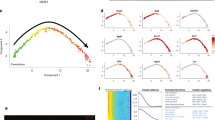Summary
Involucrin, the major protein precursor of the cornified envelope, is expressed during terminal differentiation of human keratinocytes, both in vivo and in vitro. In epidermis, the onset of synthesis is several layers above the basal layer, but in stratified cultures of keratinocytes on tissue culture plastic involucrin synthesis begins in the first suprabasal layer. To investigate the reason for this premature expression, the distribution of involucrin was studied in epidermis from different body sites, in organotypic cultures and in transplants of keratinocytes onto nude mice. We found that premature expression was not associated with poor morphological differentiation, because involucrin synthesis began immediately above the basal layer even when distinct basal, spinous, granular and cornified layers were formed in organotypic cultures recombined with dermis. The site of involucrin expression in culture did not depend on the number of cornified layers present. The only conditions which resulted in an upward shift in the site of synthesis were in 3-week old transplants on nude mice. We conclude that the site of onset of involucrin synthesis is not determined by the degree of morphological differentiation of the tissue, and discuss other factors which may be involved.
Similar content being viewed by others
References
Asselineau D, Bernard BA, Bailly C, Darmon M, Pruniéras M (1986) Human epidermis reconstructed by culture: is it “normal”? J Invest Dermatol 86:181–186
Banks-Schlegel S, Green H (1980) Formation of epidermis by serially cultivated human epidermal cells transplanted as an epithelium to athymic mice. Transplantation 29:308–313
Banks-Schlegel S, Green H (1981) Involucrin synthesis and tissue assembly by keratinocytes in natural and cultured human epithelia. J Cell Biol 90:732–737
Bernard BA, Reano A, Darmon YM, Thivolet J (1986) Precocious appearance of involucrin and epidermal transglutaminase during differentiation of psoriatic skin. Br J Dermatol 114:279–283
Boukamp P, Fusenig NE (1984) The influence of substrate and mesenchyme on the growth and differentiation of human kertinocytes in vitro. Eur J Cell Biol 33:4
Boukamp P, Rupniak HTR, Fusenig NE (1985) Environmental modulation of the expression of differentiation and malignancy in six human squamous cell carcinoma cell lines. Cancer Res 45:5582–5592
Breitkreutz D, Bohnert A, Herzmann E, Bowden PE, Boukamp P, Fusenig NE (1984) Differentiation specific functions in cultured and transplanted mouse keratinocytes: environmental influences on ultrastructure and keratin expression. Differentiation 26:154–169
Dover R, Potten CS (1983) Cell cycle kinetics of cultured human epidermal keratinocytes. J Invest Dermatol 80: 423–429
Fusenig NE (1986) Mammalian epidermal cells in culture. In: Bereiter-Hahn J Matoltsy AG, Richards KS (eds) Biology of the integument, vol 2, Vertebrates. Springer, Berlin Heidelberg New York, pp 409–442
Fusenig NE, Breitkreutz D, Lueder M, Boukamp P, Worst PKM (1981) Keratinization and structural organization in epidermal cell cultures. In: Schweiger HG (ed) International cell biology 1980–1981. Springer, Berlin Heidelberg New York, pp 1004–1014
Fusenig NE, Breitkreutz D, Dzarlieva RT, Boukamp P, Bohnert A, Tilgen W (1983) Growth and differentiation characteristics of transformed keratinocytes from mouse and human skin in vitro and in vivo. J Invest Dermatol 81:168s-175s
Green H (1977) Terminal differentiation of cultured human epidermal cells. Cell 11:405–416
Green H (1980) The keratinocyte as differentiated cell type. Harvey Lect 74:101–139
Green H, Watt FM (1982) Regulation by vitamin A of envelope cross-linking in cultured keratinocytes derived from different human epithelia. Mol Cell Biol 2:1115–1117
Green H, Fuchs E, Watt F (1982) Differentiated structural components of the keratinocyte. Cold Spring Harbor Sympos Quant Biol 46:293–301
Holbrook KA, Hennings H (1983) Phenotypic expression of epidermal cells in vitro: a review. J Invest Dermatol 81:11s-24s
Karasek MA (1983) Culture of human keratinocytes in liquid medium. J Invest Dermatol 81:24s-28s
Mackenzie IC, Fusenig NE (1983) Regeneration of organized epithelial structure. J Invest Dermatol 81:189s-194s
Murphy GF, Flynn TC, Rice RH, Pinkus GS (1984) Involucrin expression in normal and neoplastic human skin: a marker for keratinocyte differentiation. J Invest Dermatol 82:453–457
Potten CS (1983) Kinetic organisation in squamous epithelium. In: Wright NA, Camplejohn RS (eds) Psoriasis: cell proliferation. Churchill Livingstone, Edinburgh, pp 149–162
Pruniéras M, Régnier M, Woodley D (1983) Methods for cultivation of keratinocytes with an air-liquid interface. J Invest Dermatol 81:28s-33s
Rice RH, Green H (1979) Presence in human epidermal cells of a soluble protein precursor of the cross-linked envelope: activation of the cross-linking by calcium ions. Cell 18:681–694
Simon M, Green H (1984) Participation of membrane-associated proteins in the formation of the cross-linked envelope of the keratinocyte. Cell 36:827–834
Sun TT, Green H (1976) Differentiation of the epidermal keratinocyte in cell culture: formation of the cornified envelope. Cell 9:511–521
Watt FM (1983) Involucrin and other markers of keratinocyte terminal differentiation. J Invest Dermatol 81:100s-103s
Watt FM (1984) Selective migration of terminally differentiating cells from the basal layer of cultured human epidermis. J Cell Biol 98:16–21
Watt FM, Green H (1981) Involucrin synthesis is correlated with cell size in human epidermal cultures. J Cell Biol 90:738–742
Watt FM, Green H (1982) Stratification and terminal differentiation of cultured epidermal cells. Nature 295:434–436
Watt FM, Mattey DL, Garrod DR (1984) Calcium-induced reorganization of desmosomal components in cultured human keratinocytes. J Cell Biol 99:2211–2215
Weiss RA, Eichner R, Sun TT (1984) Monoclonal antibody analysis of keratin expression in epidermal diseases: a 48-and 56-kDalton keratin as molecular markers for hyperproliferative keratinocytes. J Cell Biol 98:1397–1406
Worst PKM, Mackenzie IC, Fusenig NE (1982) Reformation of organized epidermal structure by transplantation of suspensions and cultures of epidermal and dermal cells. Cell Tissue Res 225:65–77
Wu YJ, Parker LM, Binder NE, Beckett MA, Sinard JH, Griffiths CT, Rheinwald JG (1982) The mesothelial keratins: a new family of cytoskeletal proteins identified in cultured mesothelial cells and nonkeratinizing epithelia. Cell 31:693–703
Author information
Authors and Affiliations
Rights and permissions
About this article
Cite this article
Watt, F.M., Boukamp, P., Hornung, J. et al. Effect of growth environment on spatial expression of involucrin by human epidermal keratinocytes. Arch Dermatol Res 279, 335–340 (1987). https://doi.org/10.1007/BF00431227
Received:
Issue Date:
DOI: https://doi.org/10.1007/BF00431227




